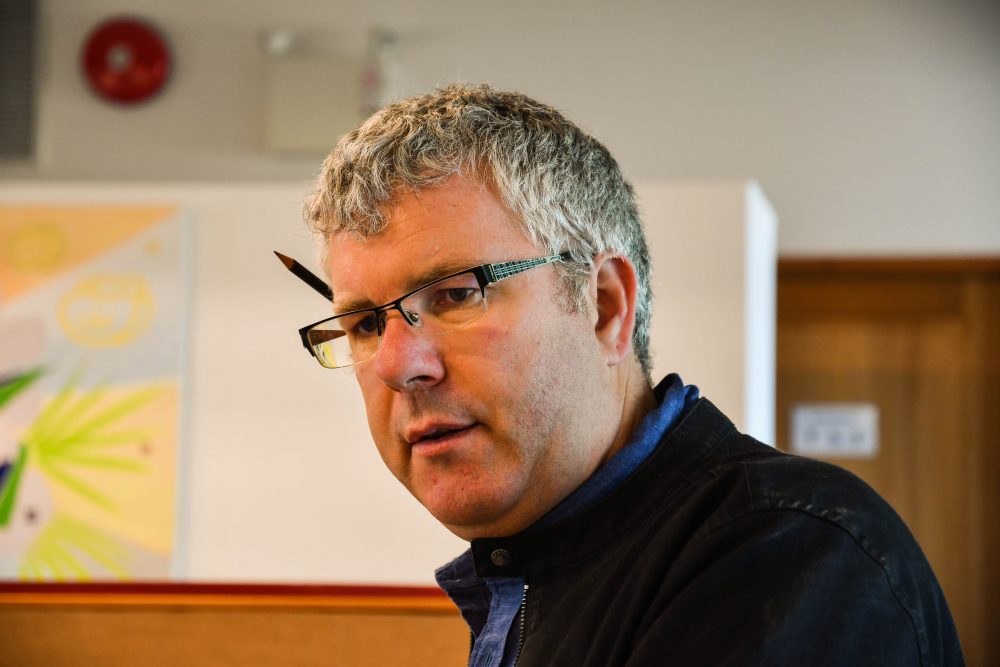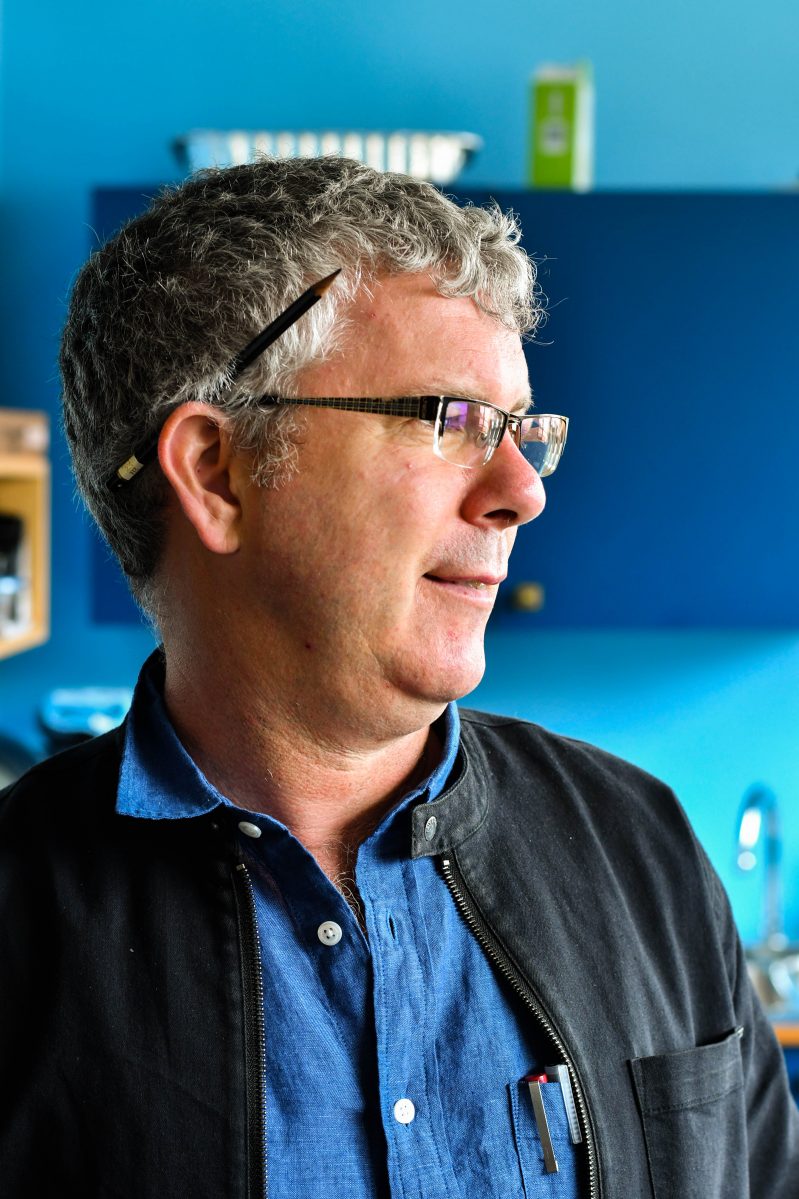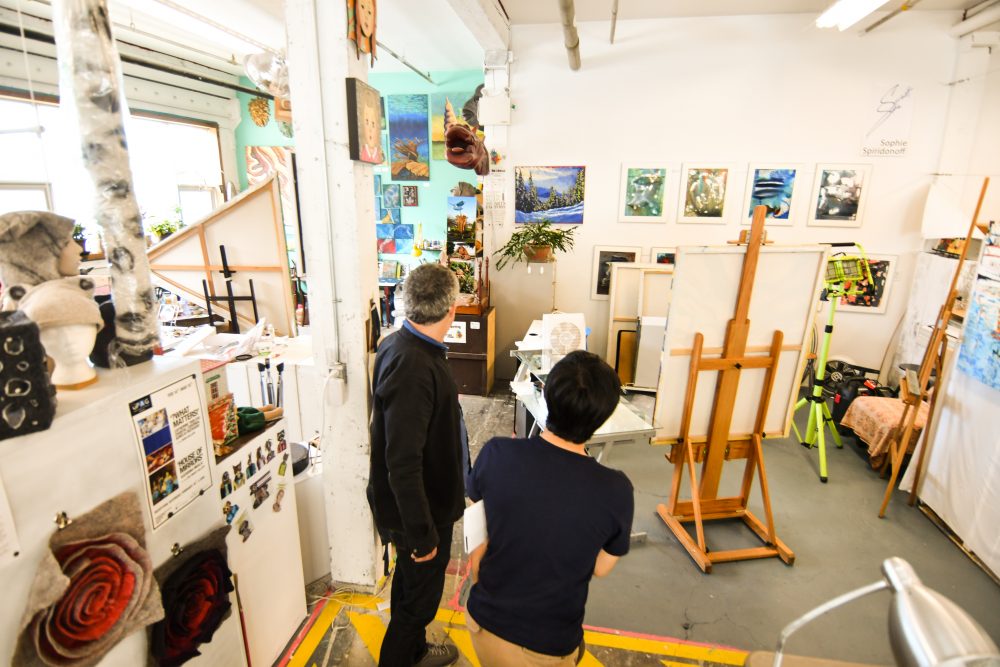Our Living City: In Conversation with Elia Kirby about the False Creek Flats and the Arts Factory
We talked with Elia Kirby from the Great Northern Way Scene Shop, a production services and custom fabrication company that has served Greater Vancouver’s cultural community and supported local artisans and craftspeople since 2003. The Great Northern Way Scene Shop is housed in the Arts Factory Society, a cultural hub for new and emerging artists, arts organizations, and cultural sector professionals, located on the edge of the False Creek Flats. The Arts Factory provides important services and support for Vancouver’s theatre and movie industries as well as for individual artists. It is an important site for Vancouver’s arts and culture community.
Disclaimer: The views expressed below belong to those being interviewed and do not necessarily reflect the opinions of Heritage Vancouver.
All images were taken by Ben Geisberg.

What’s the background of the Arts Factory?
The Great Northern Way scene shop has been working since 2003 with local artists, especially small theatre artists. We had an established base with public artists because it’s a resource-heavy activity. When the threat to losing our space at the Great Northern Way campus, the old Finning Caterpillar site, became real, we started the non-profit to move into here. Around 2010/11, when the Rise project was going in at Main and Broadway, there was big public outcry about artist spaces. There was a council motion at the time to find an existing city-owned building to find artists spaces. Council motions don’t necessarily have research, background, and planning that a staff-driven project would; however, staff then rushed around to find an appropriate space. They then published a Request for Proposal (RFP) for the space and people who knew about space development said they wanted 10 years, including us. Our proposal was to move the Scene Shop to here, take over half the space for the scene shop, and turn the other half into artist studios and coworking space. City staff recognized the role that we played for the theatre community and recognized the need to save the scene shop. We also had some funding from a heritage grant. After we moved in, it took about a year to get the lease together and another two for the city to do base building upgrades and another six months for us to finish tenant improvements.


So, in 2010 the city had its ideas about what would be happening here 5-10 years later?
No, they didn’t necessarily know what they wanted to do. Now the City is re-planning this entire area. This whole 10-acre area surrounding the building is owned by the city and was recently re-zoned as an “innovation hub”, a brand-new zoning, which is ultimately mixed-use zoning. I think this is problematic since it is not well-thought through and is basically going to encourage gentrification of the area. It’s planned that this building will be torn down.

What is zoning in the Innovation Hub?
It’s an artisanal zoning on the ground floor where if you build or make it you can sell it. Sounds great for small artists but it really just encourages groups like Aritzia and larger organizations to have a factory store. And then floors 2 & 3 would be mixed-use office/industrial space and 4 & 5 are residential.
So most tenants are aware of upheaval in the next 5-10 years?
Yes, and we have an option to renew our lease at the end of 10 years which we would like to exercise. And I am the representative negotiating all of this with the city; there’s a board to make decisions. It’s working with politicians, staff, and publicly to raise awareness.

What is the status of these negotiations with the city?
Well, the city’s opaque and every single department has its own focus. So some departments will be supportive and some will be less supportive; at the end of the day, the ones that make the most decisions around physical assets, is real estate. And they’re charged with making money for the city. And it is what it is. Anything we do is going to require council support. Vision was very supportive of us and they did recognize there was a need and made something happen. I think Kennedy Stewart has been great. He presented his Arts and Culture policy from within the Arts Factory, so he certainly gets it. But he’s one voice. And council is rightly so very concerned about the cost of living and state of real estate, rent, and housing in Vancouver. So that’s going to consume council for most of this mandate and we’ll see. Without any other direction from council, staff will carry on presuming that this space will be torn down.
If the city says that they’ll give you equivalent space, why do you want this building specifically?
We think there is value in keeping it for a variety of reasons. One, it is exemplary of an art-deco style we don’t see anymore. The north-facing skylights are amazing for artist studios; we’d love to have the whole building for the artist and maker community or light industrial. Dan-D-Pak was here before us and we didn’t have to change anything in the industrial space since it was industrial already. For example, there is a ventilation room so people can have a space if there’s something that requires airing out. In that way, the industrial nature is good for us.
Originally, they said they were going to go five stories nearby in a new building and move us there. However, given the nature of costs for building new, our lease costs are more than likely to go up quite considerably. The other issue is that we’re unlikely to get the same quality of space that we currently have anywhere else. It’s unlikely a developer would be that generous with space and the City won’t say they’ll maintain the cost that we currently have, not even if there was an increase for inflation. We are renting below market in a building that has paid off itself and the bank is not beholden to get money out of this building. And part of it is ideological. I don’t think you need to be constantly tearing down buildings to get something that is working.
What’s the value of industrial space?
Jobs. By the city’s own published records, the industrial area is about 17% of available land use, and it provides 50% of the jobs in Vancouver, which is an incredible demand on a very small amount of space. Their plan to increase residential in industrial land is threatening the viability of that activity. If you push this out to the suburbs, it’ll be hard to retain staff. And for the creative people who live here, lots want to live in urban areas. We have 25 full-time staff and 25 part-time staff between the various businesses here.
I also like that our space allows for low capital investment by small and emerging entrepreneurs. We’re looking at a situation where so many of our commercial enterprises are becoming large corporations that require lots of investment. Something like us [artists], someone just needs enough to pay for their cost of living and studio rent for 3 or 4 months to get up and running so they can go to university or art or trade school, get out of school and in a couple of years, have a thriving business [artistic practice] without a lot of capital investment. We have a young person in here out of art school who is probably paying $200/month which includes utilities, and they are able to survive and thrive in here supporting themselves full-time with their art.

Can you give us an idea of what you had to go through to make this place happen?
We used to joke that if we had known the kind of work we were getting into, we probably wouldn’t have done it. It’s a lot of work. It was a lot of stressful work. Being a developer without any cash, we relied on government grants, you need to be patient, somehow you need to come up with the cash to do it, and it’s expensive. We raised $1.3 million for our own tenant improvements. The city won’t tell us how much they put in. That doesn’t include the volunteer labour that we put into it which would probably make this a $5 million development. And it was fast, only about four years. I didn’t have nearly as much grey hair before. It’s a steep learning curve and you have to be prepared for that. You need to surround yourself with solid people. The advice you get from professionals and your peers is really important and you have to be in for the long-haul. And you really have to be very clear about the story you want to tell. When you are directing, one of the things they say is that you tell the story that you are going to tell and through the entire process you keep telling everybody, what’s the story. You keep telling people, that’s the goal and eventually people figure it out and start working towards that goal at the same time. Would I do it again? I don’t know if I’d volunteer again. I still think it’s incredibly important that we do this. Every time a small not for profit or community minded business creates something like this, we continue to write the story of what kind of community we want to be in. Otherwise, it’s getting to the point where it’s development by people who we have no access to.


There’s obviously a lot of pride and identity tied into this building. If they demolished this building, you’d be quite gutted wouldn’t you?
I’d be gutted but I’m enough of a pragmatist to know that could happen. There definitely would be a human cost. We put a lot of effort into this, we made decisions. This building has lots of found parts. Someone had trim and veneer from another project and I thought I could use that here. You’re very aware of the costs – emotional, physical and financial. I look around and think that a lot of us don’t recognize the city you’ve lived in for the last 20 or 30 years. Those touchstones and landmarks are important to us. Cities need to be relatable and there’s a monotony to the buildings going in or there’s this starchitect that drops amazing buildings that look great in photos but the average person doesn’t relate to it.
What is the importance of artists in this city?
For most of the emerging or mid-level artists, they’re telling stories. They’re inherently important because it provides the inspiration and reason for being that’s about who we are, why we do it, what we strive for, is what artists are engaged in. Your average fabric shop is not engaged with why we do something or what the value is; but artists are concerned with the inherent nature of how art is asking those types of questions. And if you threaten the existence of that in your community or push it into a rarified stream of artists, then you’re not challenging or questioning the status quo. You’re eliminating that question from your social sphere and it’s lost. And there’s a lot of pandering over space and the cost of space, and the cost on the artist community; I know lots of artists who have left for various reasons and we need to be conscious of that. It was in the middle of this crisis that the Arts Factory emerged and, to offset the loss we’re seeing, I would like to see more organizations like the Arts Factory pop up.
